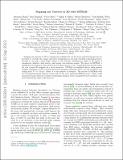Mapping our universe in 3D with MITEoR
Author(s)
Tegmark, Max Erik; Buza, Victor; Dillon, Joshua Shane; Gharibyan, Hrant; Kunz, Eben A.; Liu, Adrian Chi-Yan; Losh, Jonathan L.; Lutomirksi, Andy; Morrison, Scott D.; Narayanan, Sruthi A.; Perko, Ashley; Rosner, Devon; Sanchez, Nevada; Schutz, Katelin; Tribiano, Shana; Valdez, Michael; Zelko, Ioana; Zheng, Kevin; Ewall-Wice, Aaron Michael; Matejek, Michael Scott; Morgan, Edward H.; Neben, Abraham Richard; Pan, Qinxuan; Penna, Robert; Su, Meng; Villasenor, Joel; Williams, Christopher Leigh; Yang, Hung-I; Zhu, Yan; Zheng, Haoxuan, Ph. D. Massachusetts Institute of Technology; ... Show more Show less
DownloadTegmark_Mapping our.pdf (3.580Mb)
OPEN_ACCESS_POLICY
Open Access Policy
Creative Commons Attribution-Noncommercial-Share Alike
Terms of use
Metadata
Show full item recordAbstract
Mapping our universe in 3D by imaging the redshifted 21 cm line from neutral hydrogen has the potential to overtake the cosmic microwave background as our most powerful cosmological probe, because it can map a much larger volume of our Universe, shedding new light on the epoch of reionization, inflation, dark matter, dark energy, and neutrino masses. We report on MITEoR, a pathfinder low-frequency radio interferometer whose goal is to test technologies that greatly reduce the cost of such 3D mapping for a given sensitivity. MITEoR accomplishes this by using massive baseline redundancy both to enable automated precision calibration and to cut the correlator cost scaling from N[superscript 2] to N log N, where N is the number of antennas. The success of MITEoR with its 64 dual-polarization elements bodes well for the more ambitious HERA project, which incorporates many identical or similar technologies using an order of magnitude more antennas, each with dramatically larger collecting area.
Date issued
2013-10Department
Massachusetts Institute of Technology. Department of Mathematics; Massachusetts Institute of Technology. Department of Physics; MIT Kavli Institute for Astrophysics and Space ResearchJournal
Proceedings of the 2013 IEEE International Symposium on Phased Array Systems and Technology
Publisher
Institute of Electrical and Electronics Engineers (IEEE)
Citation
Zheng, Haoxuan, Max Tegmark, Victor Buza, Josh Dillon, Hrant Gharibyan, Jack Hickish, Eben Kunz, et al. “Mapping Our Universe in 3D with MITEoR.” 2013 IEEE International Symposium on Phased Array Systems and Technology (October 2013).
Version: Original manuscript
ISBN
978-1-4673-1127-4
978-1-4673-1126-7